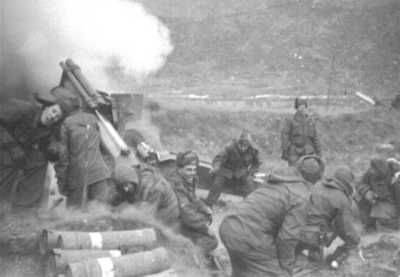1950 - 1953

Ed Milburn pulling the cord on the first round the 623 fired in Korea
From 1945 to 1950 the Kentucky National Guard undertook major reorganization. New battalions and companies were initiated while the older units were either maintained intact or merged into new battalions.
Effective May 24, 1946, the 359th Fighter Group and the 368th Fighter Squadron of the U.S. Army Air Corps were designated as the 123rd Fighter Group and the 165th Fighter Squadron, and allotted to the state of Kentucky. The two organizations were designated by the War Department to receive the insignia, World War II battle credits and honors of their forerunners. The units received Federal recognition on February 16, 1947.
With hostile activities occurring in Korea in June of 1950, on October 10, 1950, President Harry S Truman placed the 123rd Fighter Group on active duty. The unit was moved from Standiford Field in Louisville to Godman Field, Fort Knox, Kentucky, where the units were reorganized under a Wing Headquarters. The unit's F-51 "Mustang" aircraft (being flown by the unit) were sent to the Far East, and many of the pilots saw voluntary combat duty in Korea. Five of the pilots were lost in action during the war.
In November 1951, the Wing was ordered to replace the Strategic Air Command's 12th Fighter Escort Wing at Manston R.A.F. Station near Margate, England. Fighter squadrons of the 123rd, equipped with the F-84 "Thunderjet," participated in joint operations with other NATO units during the European deployment. The units were officially deactivated in July 1952 and returned to Air National Guard status.
The 623rd Field Artillery Battalion, headquartered in Glasgow, Ky., with firing batteries in Tompkinsville, Campbellsville, Monticello, and service battery from Springfield, was alerted on December 23, 1950. It was to enter into active service commencing January 23, 1951. On February 2, 1951, the Battalion boarded a troop train for Fort Bragg, N.C. The 155 howitzers and prime mover tractors were shipped ahead of the men and had reached Fort Bragg before the Advance Party arrived. The Advance Party consisted largely of administrative personnel who lacked training in operating the prime movers that had to unload the flat cars because Fort Bragg authorities declined to do so.
At the date of activation the battalion was redesignated from a 155-tractor-drawn howitzer battalion to an armored field artillery battalion. This designation remained for eleven months. The 623rd never received the self-propelled weapon but received half-tracks and other armored inventory.
While at Fort Bragg the battalion qualified itself to carry out its duties in Korea.
About November 19, 1951, the unit was shipped by two troop trains to San Francisco, California. The battalion was processed at Camp Stilton for one week prior to embarking for South Korea. On December 22, 1951, the battalion reached Pusan where it lived in a tent city for two weeks. The unit was then transported up the eastern coast of Korea by Navy LST's and put ashore at Sachari, about 40 miles south of the 38th Parallel.
After a 90-mile march to its position area in Mundung-ni Valley, which was north of the 38th Parallel and approximately 35 miles from the east coast of Korea, for a period of time A Battery of Tompkinsville had the distinction of being the northernmost allied unit in Korea. Mundung-Ni was in the mountainous area of Korea with valley floors ranging from 400 yards to one mile wide.
The howitzers and track vehicles had to be unloaded from the trains that had brought them from Pusan. Then they had to be motored 40 miles to the Mundung-Ni Valley. One particularly hazardous mountainous area was named the Kansas Pass, which was similar in features to the Smoky Mountains. The track vehicles were helpless on snow and ice. The tracks would merely spin in an attempt to climb the mountains. The problem was solved by commanding 21/2- and 3/4-ton trucks to tow the prime movers enough so that the tracks would catch. Once on the top of the mountain, the problem was not solved. When the prime mover would descend it would slide and control lost. One howitzer and prime mover were lost over the side of a 700-foot bank; fortunately, no one was injured. Before nightfall the howitzers and prime movers reached the position area with only the one loss. The mission of the 623rd Field Artillery was general support of the Tenth Corps and reinforcing the fires of the First Korean Rock Division. At this time the peace talks at Panmunjam had started and fighting was at a stalemate. However, there was still much artillery fire. The weather was cold and the ground was frozen so solid that sanitation fills could not be built. Rats became a great problem. The major concern was the fatal disease that these rodents carried.
In July 1952, the battalion was moved to the eastern side of the punchbowl at a site called Smoke Valley. The name came from the smoke that was generated by a special company 24 hours a day to deny the Chinese and North Koreans visibility. After performing an outstanding service in supporting the Tenth Corps the battalion was inactivated and returned home in the late fall of 1952.
During the Korean War, 10 Kentucky Guard units, including four battalions, five companies, and the entire Kentucky Air National Guard, were called into Federal service. The 623rd Field Artillery was the only one to be deployed as a unit to the front lines, earning four campaign credits and awarded the Republic of Korea Presidential Unit Citation.
One of the five Air Guard casualties was Captain Thomas Shewmaker; the Kentucky Air Guard Base located in Louisville is named in his honor. A total of 88, 273 Kentuckians served in the Korean War. 1,025 were casualties.
Additional Resources